Elegy for a metronome, Hisaishi at the orchestra, and the joy of jumps
My metronome died last week. Or maybe it was the week before, I don’t know. (Cue the worried texts from my friends going “Sharon are you trying to be Camus?”)
I thought the batteries were just going—the screen had started fading a bit, and it was becoming more reluctant to turn on—and then one day it just gave up the ghost in the middle of my scales. I shrugged, popped in some fresh AAAs, and hit the On button, only for nothing to happen.
 Why yes, I did just stage a little photoshoot with my dead metronome like a creepy Victorian, and yes it is plastered with "I Voted" stickers.
Why yes, I did just stage a little photoshoot with my dead metronome like a creepy Victorian, and yes it is plastered with "I Voted" stickers.
You know how in movies, people will shake their suddenly bestilled companion, screaming, “Please wake up! You can’t leave me like this! It’s not your time!” etc.? That was me with my little blue Korg. I held it in my hands like a dead baby bird, smashing the On button with increasing violence (okay, so not like a baby bird), trying in vain to coax it back to life.
Eventually I figured out that I could reanimate my metronome if I did unspeakable things to it (thrust a pen into the On button, wiggle the pen around like a brute until I found a random sweet spot, then set it down and hope it didn’t spontaneously turn off again) but realized I couldn’t live like this, and it was simply time to get a new metronome.
It’s very weird to realize you have an emotional attachment to a small device you paid $20 to shriek rhythmically at you in perpetuity. It’s like getting in too deep with a robot woodpecker. But as the productive potential of my practice session collapsed around me (my group chat: “Can’t you just use the metronome app on your phone???”) I found myself grieving a little, not so much for the metronome itself, but for what felt like the End of an Era.
For you see, my little blue Korg came into my life to herald a transition. For most of my teens and the entirety of my undergraduate music education, I used a little white Intelli with a tuning function; this little buddy got me through years of furious practice sessions on both the piano and violin, of preparing for rounds of recordings and auditions that felt life-defining, and it rode and flew with me everywhere I went to play.
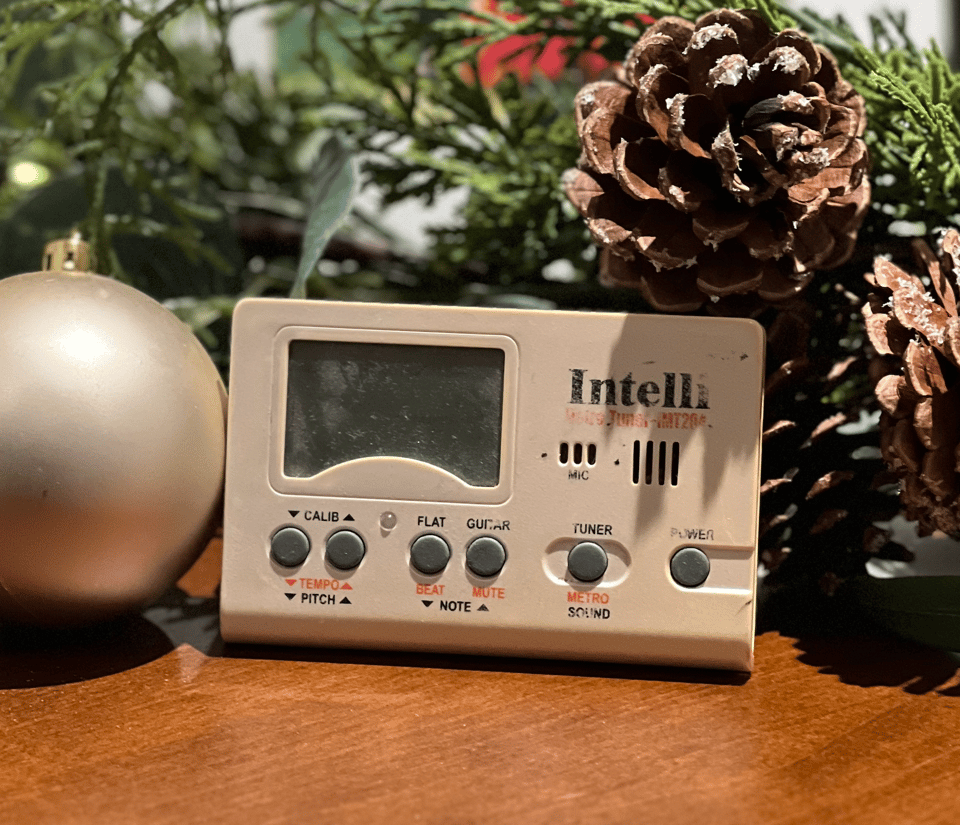 Yes, I still have it, and yes, again with the dead metronome photoshoot.
Yes, I still have it, and yes, again with the dead metronome photoshoot.
It died shortly after I started lessons with the teacher who I did not realize at the time would be my Last Major Teacher, who with my tremulous agreement broke me down and built me back up, undoing a lifetime of bad habits and reshaping the way I listened to and learned music. It was as if a few weeks of existentially terrifying lessons and ferocious practice sessions had made it clear to the little white metronome that things had changed and it could go no further with me. So it went on permanent strike, I frantically ordered the little blue Korg online, and it rose magnificently to the challenge, accompanying me with a maddeningly steady beat as I drilled new exercises and pushed myself the hardest I’d ever gone in my life, reminding me that I’m always, always rushing.
I’ve been grappling for the last couple of years with the realization that I am not a student anymore, a theme that has quietly underpinned everything from a radio story about my work to, well, pretty much most of what I write about for this newsletter. But no matter how far away I’ve gotten from my last lesson, I’ve had the little blue Korg on my piano, making me feel like it was only yesterday that my new teacher assigned me, a person who had just performed Prokofiev’s Third Concerto like my life depended on it, some C Major scales and a simple Mozart sonata and made me undo everything I thought I knew about music.
I know I’m anthropomorphizing a little machine and putting way too much dramatic stock in what is ultimately a very random and inevitable event (cheaply made electronic fails after a decade of extremely heavy use), to a degree that mental health professionals might deem “extremely concerning,” but what is the point of being an artist if you can’t be overly dramatic about things?
Anyway. I went to go order a new metronome, and realized that because I primarily practice at home now, and don’t have to keep my metronome in a bag I tote to practice rooms and lessons, I’m no longer limited to tiny portable card-shaped metronomes. This thing will live on my piano permanently, and therefore there are OPTIONS!
So I fell down a metronome rabbit hole, which, believe it or not, did actually include some rabbits:
 Source—if you are so inclined, there are many Hello Kitty metronomes on Ebay.
Source—if you are so inclined, there are many Hello Kitty metronomes on Ebay.
And I fell so deep that the darkness took me, and I strayed out of thought and time, and ended up dragging a friend down with me who ended up buying a new metronome too (hi Jen! Hi Cecilia Beatoli!). After agonizing over aesthetics and functionality, I happened upon this little cutie from Korg, which manages to evoke the look of a traditional pendulum metronome while having the functionality of a digital one (I NEED my subdivisions).
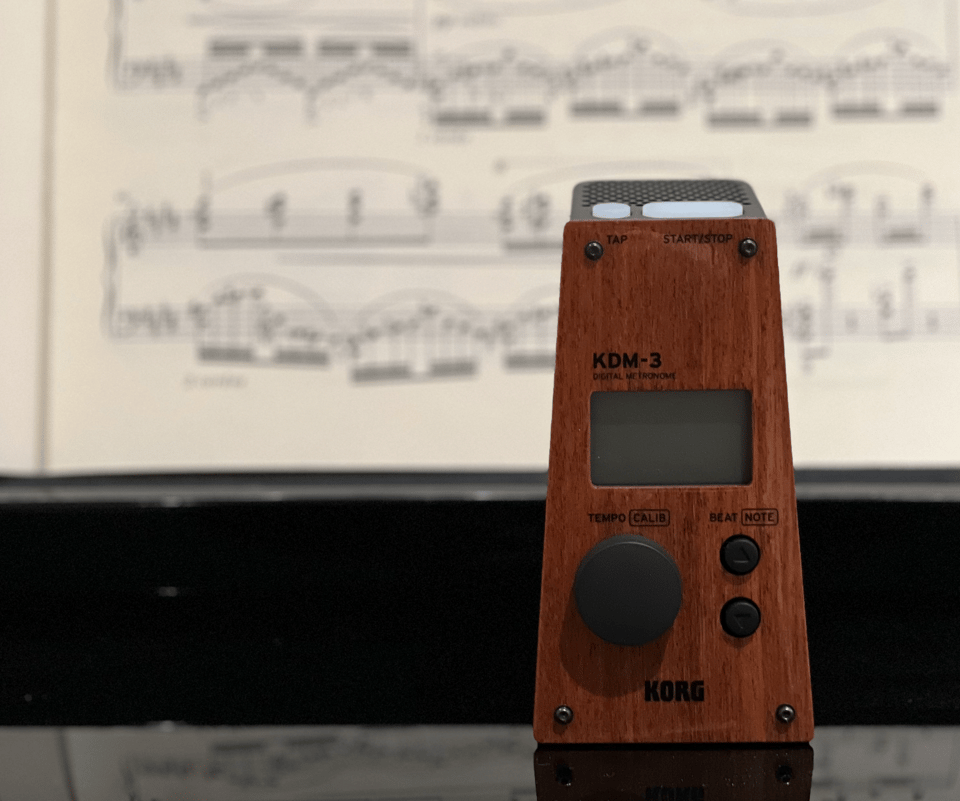
The metronome does not have a name. I refuse to name it. You see how broken I was by the death of the little blue Korg, can you imagine how much worse it would be if I bestowed full personhood upon it?
 Three generations of metronomes. I have no clue what I'm supposed to do with two dead metronomes now.
Three generations of metronomes. I have no clue what I'm supposed to do with two dead metronomes now.
Stop, Hisaishi Time!
I have previously written about my love for Joe Hisaishi’s Ghibli film music and what makes his writing so brilliant, as well as my auditory dabbling in his non-film music. Well, last month I went to hear him conduct a magnificent program with the LA Phil: his own Adagio for Strings and Two Harps and the world premiere of his Harp Concerto, as well as the Ravel orchestration of Mussorgsky’s Pictures at an Exhibition.

Composers don’t always make great conductors. (Even certain superstar instrumentalists don’t make great conductors; orchestral musician friends have confirmed this.) I’m not going to name names, but last season I went to another concert at Walt Disney Concert Hall where a composer (whose music I actually like!) conducted their own music and a Ravel piece, and…I kind of thought they sucked. Not in a “the music sounds bad” kind of way, but in a “you’ve brought absolutely nothing new to the music” way—their own piece didn’t do anything for me (whereas when I heard Dudamel conducting their music, it was so rich and alive), and I got nada out of their interpretation of Ravel, as they wasted all their expressiveness on their little dance moves, and didn’t translate any of that into the sound. (I am definitely getting inundated with DMs asking me who I’m talking about, huh.)
Hisaishi’s conducting, though, was a freaking revelation. He had a way of making his compositional intentions super clear—something you’d think would be a given for a composer conducting their own work, but as my other experience showed, that’s not always the case!
His Harp Concerto—a world premiere featuring Emmanuel Ceysson, who the piece was written for, as the soloist—made a strong case that the envelope of sound that forms after impact can be one of music’s most compelling elements. The most obvious challenge of writing a harp concerto is that a full-blown orchestra is very loud and the harp, as a solo instrument, is…well, not. (Harps are louder than you think, but they’re no piano.)
If I were orchestrating a harp concerto I’d get around this problem by stripping the orchestra down and using little to no brass (which is why I am not remotely qualified to orchestrate a harp concerto), but Hisaishi is too clever for that. Instead of defanging the orchestra, he kept the percussion and brass sections absolutely stacked and played with sound envelopes and all the delightful textures at a modern orchestra’s disposal, and graded it all so skillfully that you never lost track of Ceysson’s playing nor felt like the orchestra was pulling its punches.
The concerto, essentially, was a celebration of percussion’s subtleties (and was a reminder that the harp, while stringed, is technically a percussion instrument!). Judging from my copious notes, the second movement was my favorite; Hisaishi utilized a 6/8+7/8 rhythm that had a gorgeous lilt to it but, thanks to that extra odd dance step, was just unsettling enough to suspend the listener in a state of not knowing. He teamed the piano and harp in tight lockstep, sprinkling in the celeste and other percussion, and assigning the glockenspiel syncopated off-beats that gave me the impression it was running, impossibly, through raindrops. This fiendishly exposed percussion setup with its minimalist filigrees was so intoxicating that it made me feel giddy just watching, and by the time we hit the cadenza that transitioned into the third movement, it was like I was drunk.
I don’t know whether it was Ceysson or Hisaishi who was behind it, but the things being done to that harp during the cadenza filled me with joy; Ceysson used different implements to prepare the harp and get different percussive sounds and flamenco-like rhythms out of it, and every once in a while he reminded us of something all pianists and harpists secretly know: that smacking a stringed percussion instrument with your open hand is 1) extremely fun and 2) makes the funnest resonant sound.
The third and final movement was driven by rhythms that managed to be propulsive without being frenetic—I saw an audience member in front of me bopping his head to the rhythm, and then realized that I was tapping my toes inside my own boots. Once again, Hisaishi designed the orchestration around the harp’s sound without making it seem like a limitation; I was thrown by the simple effectiveness of the way, for example, he deployed a hand-muted triangle, and how he summoned the winds and brass for quick, in-your-face signpost moments, then brought the other instruments in to paddle around in the receding wave of sound.
I’m the first to admit that I’m a terrible orchestrator (and therefore am probably missing a lot of things), but even I could appreciate the staggering mastery he had over the form; he pulled unexpected vertical colors out of the ensemble, while maintaining horizontal movement by splashing sonic attention on rhythms and textures. And all through this, he conducted with graceful, pianistic wrist motions, with a sense of calm that had a way of making me forget what a firm hand he had on the reins.
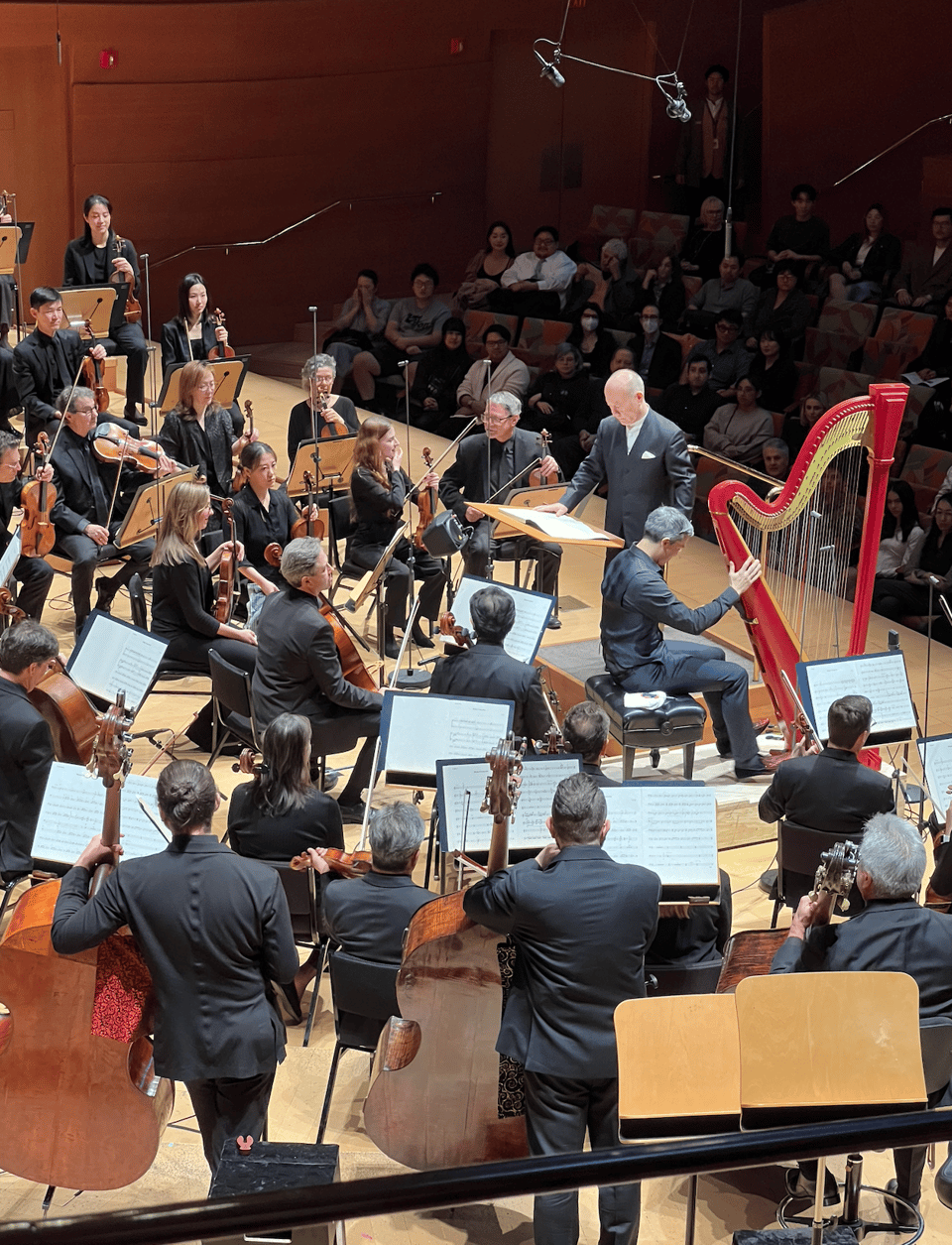
By the time the second half of the program—Mussorgsky’s Pictures at an Exhibition—rolled around, I was prepared to have a good but not-as-amazing-as-that-harp-concerto time; Pictures is one of those pieces I love but that gets played to death. Oh me of little faith! The first half of the program had just shown me how damn good of an orchestrator Hisaishi is, so I should have known I was in for a treat.
Normally when I hear Pictures, I hear the Mussorgsky-ness of the music, with every brass fanfare and bearlike heave of the bass hearkening back to the sound of the original work for solo piano. In his Pictures, Hisaishi was conductor-as-prism, tilted so that we could all see the full spectrum of color Ravel laid out in his arrangement. I didn’t realize until that performance that you rarely get to hear a master orchestrator performed by a master orchestrator, and it blew my mind to hear how Hisaishi pulled the Ravel-ness out of this old warhorse.
Well-known and well-loved pieces like Pictures often feel like they more or less play themselves, but Hisaishi’s performance made me feel like I was discovering something new. Just as the Harp Concerto surprised me with its ingenious sound creations, I heard new colors and unexpected textures pop out at me in Pictures. Once again I realized that Hisaishi doesn’t just listen to the impact of sound, he aims for what happens after the point of impact, and he plays with the shapes left lingering in the air—it’s a whole new dimension of the orchestra, opened up, once you realize that’s something you can listen for. He did something with the brass hairpins in “Catacombs” that made me sit up and gawk, which is saying something considering that “Catacombs” is one of the most skippable of the Pictures to me.
I was most excited for “The Hut on Fowl’s Legs,” aka Baba Yaga, which I LOVE. I am guilty of listening to Baba Yaga all the time, on repeat, and not giving a single thought to any of the other movements. Baba Yaga is my jam, baby.
Once again, Hisaishi hit me with his galaxy-brain approach to sound. I’m used to the pianistic way performers—pianists and conductors alike—treat the smaller motivic notes of the Baba Yaga theme, but Hisaishi eschewed fussing over these notes in favor of creating bigger beats and larger layers. I finally appreciated what decades of frustrated piano teachers have begged me to understand: that real magic happens when you don’t overwork every single note and you can think and hear in larger cells. Sorry, teachers! Clearly you should have brought Joe Hisaishi in to show me how it’s done!
You say “jump,” I say “how high” (not very)
I recently jumped for the first time!!! On a horse, I mean. I’ve been jumping as a human being my whole life.
At the moment most of my lessons consist of me trotting breathlessly around the ring (again, on a horse), but at one recent lesson my trainer set up poles on the ground, which the horse trotted over, and then he hiked them up into low-level obstacles. Before I knew it, I was pointing the horse at them, then I was in the air, then I was bouncing wildly in the saddle as we hit the ground again. It was ohmigodSOFUN and I suddenly understood why people spend stupid amounts of money on this whole horse thing.
After clearing the obstacles over and over again, I wanted to laugh with pure, giddy joy. At the end of the lesson I ran into the tack room where another trainer was with several more advanced equestrians, all of whom were way younger than me. I didn’t care. “I did jumps for the first time!” I announced, as proud as a small child who has just been potty trained.
How much of my elation was because jumping is fun (it is) and how much of it was the thrill of learning something new? As I unpacked the feeling over the following days, it dawned on me: I haven’t felt that unspoiled sense of learning and conquering something completely new at the piano for a very long time.
Don’t get me wrong—every single time I sit down at the piano, I discover something new about myself. Every year I feel like I’m flying higher and higher on new masteries, and the more experience I put behind me the more I feel things I didn’t think were possible when I was a student, and for that reason I can’t bear to imagine what life would be if I had given music up.
But I don’t remember the last time I walked into a piano lesson not knowing how to do something at all, been given instructions, and then walked out having done it, and felt the childlike pride that comes with that kind of learning. Everything I know how to do in music, I’ve known for a long while, and I’ve almost forgotten what it feels like to be lit up by something new on a regular basis. I tunneled through the joy of doing what every little horse girl wants to do—soar through the air on the back of a magnificent creature—and found fear on the other side that by going as far as I have with something I’ve loved since I was little, parts of me have calcified.
Choosing to pursue a career in music means, as far as I can tell, perpetually being haunted by doubts, and I really didn’t need a new one to add to the list. For the sake of my mental health, I think I’m going to have to keep going with hobbies where I’m learning completely new things, and if they involve horses, well.
The kicker to all this? After an excited ride home, most of which I spent happily chattering about how fun it was to jump, I greedily scooped all the videos my husband took of my lesson off his phone and sat myself down to watch. I knew the obstacle had been set up at its lowest notch, so I wasn’t going very high, but I still pictured scenes of me looking something like this:
And what I saw instead was this:
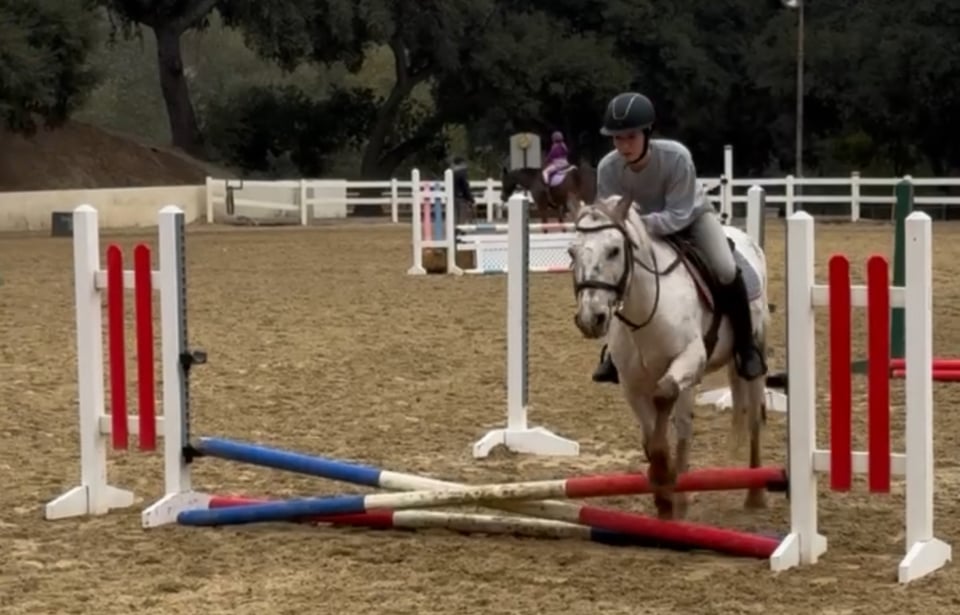
THE HORSE BARELY LEFT THE GROUND. In fact, he looks BORED.
I still stand by my idea that it’s good for me to experience the thrill of learning new things. It’s also good, clearly, for me to stay humble. 🎹
-
Such a great post!!

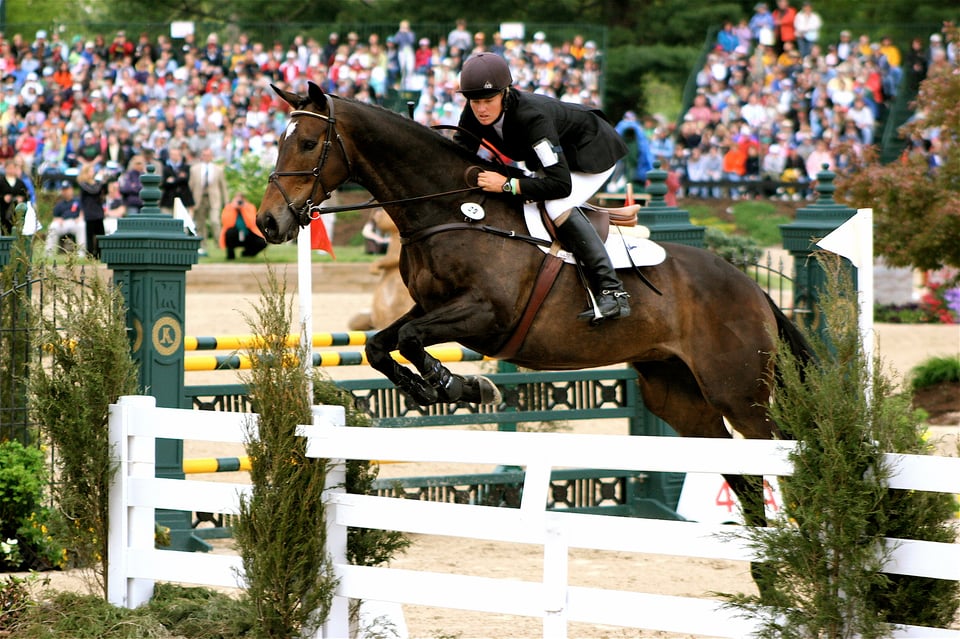
Add a comment: